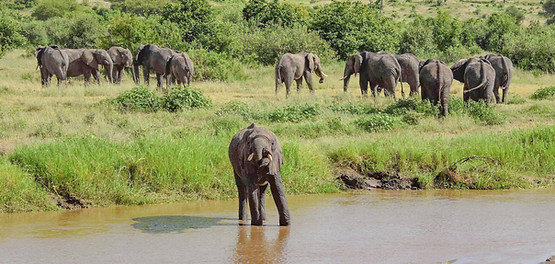
 |
|---|
TARANGIRE NATIONAL PARK

Tarangire National Park is the sixth largest national park in Tanzania. It is located in the country's northern safari circuit and is about 68 miles southwest of Arusha town. It is known for its stunning landscapes, diverse wildlife, iconic baobab trees, and majestic acacia trees, making Tarangire a photographer's dream. Covering an area of 2,600 square kilometers, it is home to a wide range of animals, including giraffes, lions, leopards, buffalos, and high density of elephants, making it a prime safari destination. While overall wildlife viewing range from fair to excellent throughout the year, the biggest attraction in this park is definitely its large herds of elephants. It is home to the largest population of elephants in Tanzania and spotting a big tusker isn't that hard in Tarangire.
Wildlife Viewing in Tarangire
During the dry season, which is from June to October, a mini wildlife migration take place in Tarangire, which sees about 250,000 animals enter the park. Large herds of migratory elephants, wildebeest, zebras, and buffalo congregate in the banks of the Tarangire River. Resident animals include giraffe, water buck, impala, eland, gazelle, vervet monkey, mongoose, baboon, lion, leopard, and cheetah. The park is haven to bird watchers being it home to more than 500 species of birds. Aside from picturesque baobab trees scattered in the park, termite mounds also dot the landscape.

When is the best time to visit Tarangire National Park?
A lot of wildlife enthusiasts and safari experts believe that the best time to visit Tarangire National Park is during the dry season, which falls on the months of June to October. There is little rainfall and animals from surrounding areas migrate into the park to access water. Vegetation thins out and animals tend to congregate around rivers and watering holes, making wildlife easier to spot. However, it is also high season from June to August, which sees the park crowded with more vehicles and tourists. During these months it is best to schedule game drives in the early mornings or late afternoons. To achieve this we have our guests stay in a lodge or tented camp inside the national park itself so early morning and sunset game drives could be done. The weather is warm and beautiful during the day, but game drives could be cold in the early morning so it's best to pack warm clothing for your safari.
You may also enjoy the park during the months of November to May when vegetation is lovely and full. Though it is wet season and lesser number of mammals are present in the park compared to dry season, wildlife viewing in Tarangire can still range from fair to very good during these months. This is also the prime time for bird watching since migratory birds are present. Other advantages of visiting the park during the wet season is enjoying the wildness of the park with less crowds and the lower rates for lodges and tented camps. Personally speaking, having been to Tarangire multiple times at different months of the year, we enjoy the park more during the wet season especially in February when the park is green and luscious, quieter and less crowded, and still with so many wonderful wildlife encounters.
So when is the best time to visit Tarangire? Dry season or wet season? It actually all boils down to personal preferences. But with us at Safaris & Treasures we love our national parks luscious, green, and teeming with life; with roads not dusty, less crowds. and minimal encounter with other vehicles during game drives.






